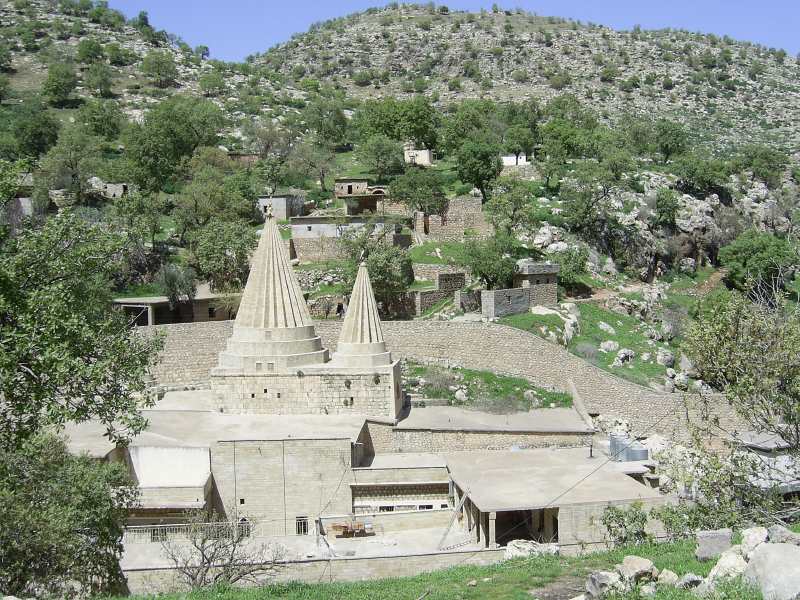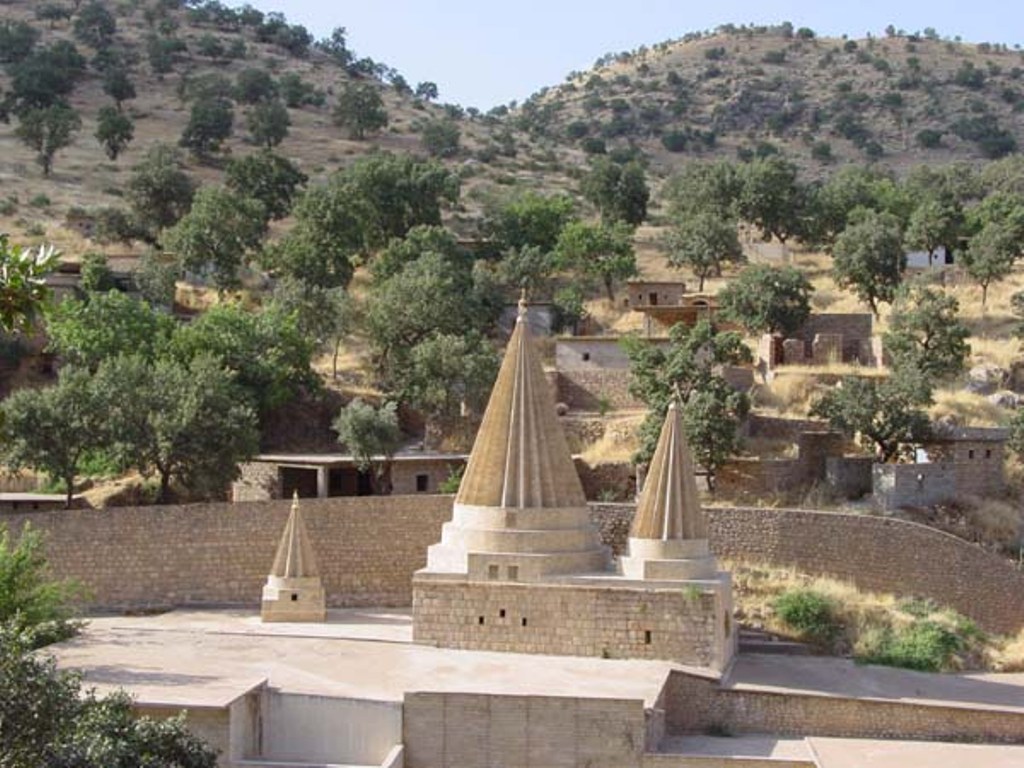|
Lalish
Lalish (, also known as Lalişa Nûranî) is a mountain valley and temple located in the Nineveh Plains, Iraq. It is the holiest temple of the Yazidis. It is the location of the tomb of the Sheikh Adi ibn Musafir, a central figure of the Yazidi faith. The temple is above the town of Shekhan, which had the second largest population of Yazidi prior to the persecution of Yazidis by ISIL. The temple is about sixty kilometers north of Mosul and 14 kilometers west from the village Ayn Sifna. The temple is built at about 861 meters above sea level and situated among three mountains, Hizrat in the west, Misat in the south and Arafat in the north. At least once in their lifetimes, Yazidis are expected to make a six-day pilgrimage to Lalish to visit the tomb of Şêx Adî and other sacred places. These other sacred places are shrines dedicated to other holy beings. There are two sacred springs called Zamzam and the Kaniya Spî (White Spring). Below Sheikh Adi's sanctuary, which also ... [...More Info...] [...Related Items...] OR: [Wikipedia] [Google] [Baidu] [Amazon] |
Yazidi
Yazidis, also spelled Yezidis (; ), are a Kurdish-speaking endogamous religious group indigenous to Kurdistan, a geographical region in Western Asia that includes parts of Iraq, Syria, Turkey, and Iran. The majority of Yazidis remaining in the Middle East today live in Iraq, primarily in the governorates of Nineveh and Duhok. There is a disagreement among scholars and in Yazidi circles on whether the Yazidi people are a distinct ethnoreligious group or a religious sub-group of the Kurds, an Iranic ethnic group. Yazidism is the ethnic religion of the Yazidi people and is monotheistic in nature, having roots in a pre-Zoroastrian Iranic faith. Since the spread of Islam began with the early Muslim conquests of the 7th–8th centuries, Yazidis have faced persecution by Arabs and later by Turks, as they have commonly been charged with heresy by Muslim clerics for their religious practices. Despite various state-sanctions in the Ottoman Empire, Yazidis historically have lived ... [...More Info...] [...Related Items...] OR: [Wikipedia] [Google] [Baidu] [Amazon] |
Yazidi Populated Places In Iraq
Yazidis, also spelled Yezidis (; ), are a Kurdish-speaking endogamous religious group indigenous to Kurdistan, a geographical region in Western Asia that includes parts of Iraq, Syria, Turkey, and Iran. The majority of Yazidis remaining in the Middle East today live in Iraq, primarily in the governorates of Nineveh and Duhok. There is a disagreement among scholars and in Yazidi circles on whether the Yazidi people are a distinct ethnoreligious group or a religious sub-group of the Kurds, an Iranic ethnic group. Yazidism is the ethnic religion of the Yazidi people and is monotheistic in nature, having roots in a pre-Zoroastrian Iranic faith. Since the spread of Islam began with the early Muslim conquests of the 7th–8th centuries, Yazidis have faced persecution by Arabs and later by Turks, as they have commonly been charged with heresy by Muslim clerics for their religious practices. Despite various state-sanctions in the Ottoman Empire, Yazidis historically have ... [...More Info...] [...Related Items...] OR: [Wikipedia] [Google] [Baidu] [Amazon] |
Yazidis
Yazidis, also spelled Yezidis (; ), are a Kurdish languages, Kurdish-speaking Endogamy, endogamous religious group indigenous to Kurdistan, a geographical region in Western Asia that includes parts of Iraq, Syria, Turkey, and Iran. The majority of Yazidis remaining in the Middle East today live in Iraq, primarily in the Governorates of Iraq, governorates of Nineveh Governorate, Nineveh and Duhok Governorate, Duhok. There is a disagreement among scholars and in Yazidi circles on whether the Yazidi people are a distinct ethnoreligious group or a religious sub-group of the Kurds, an Iranian peoples, Iranic ethnic group. Yazidism is the ethnic religion of the Yazidi people and is Monotheism, monotheistic in nature, having roots in a Ancient Iranian religion, pre-Zoroastrian Iranic faith. Since the spread of Islam began with the early Muslim conquests of the 7th–8th centuries, Persecution of Yazidis, Yazidis have faced persecution by Arabs and later by Turkish people, Turks, as ... [...More Info...] [...Related Items...] OR: [Wikipedia] [Google] [Baidu] [Amazon] |
Yazidism
Yazidism, also known as Sharfadin, is a Monotheism, monotheistic ethnic religion which has roots in Ancient Iranian religion, pre-Zoroastrian Iranian religion, directly derived from the Indo-Iranians, Indo-Iranian tradition. Its followers, called Yazidis, are a Kurdish language, Kurdish-speaking community. Yazidism includes elements of ancient Iranian religions, as well as elements of Judaism, Church of the East, and Islam."Yazīdī" ''Encyclopædia Britannica''. (2025) [1998]. Yazidism is based on belief in one God who created the world and entrusted it into the care of seven Holy Beings, known as Angels. Preeminent among these Angels is Tawûsî Melek (, also spelled as ''Melek Taûs''), who is the leader ... [...More Info...] [...Related Items...] OR: [Wikipedia] [Google] [Baidu] [Amazon] |
Sheikh Adi Ibn Musafir
Adi ibn Musafir (, ; born 1072–1078, died 1162) was a Sunni Muslim sheikh who founded the Adawiyya order. He is also considered a Yazidi saint. The Yazidis consider him as an avatar of Tawûsî Melek, which means "Peacock Angel". His tomb at Lalish, Iraq is a focal point of Yazidi pilgrimage. He was an Arab from the Umayyad dynasty. He had distant Kurdish heritage as a direct descendant of Marwan II, who was born to a Kurdish mother. Biography Sheikh Adi was born in the 1070s in the village of Bait Far, near Baalbek, in the Beqaa Valley of present-day Lebanon. He hailed from the Umayyad lineage and was a descent from Marwan II, who was born to a Kurdish mother. Sheikh Adi first received Islamic education in the nearby region, likely in Damascus. He then went to Baghdad, where he settled and continued his Islamic education with Sufi circles. He was Shafi'i. In Baghdad, Sheikh Adi was a disciple of Ahmad Ghazali, Abu al-Najib Suhrawardi, and Abdul Qadir Gilani, w ... [...More Info...] [...Related Items...] OR: [Wikipedia] [Google] [Baidu] [Amazon] |
List Of Yazidi Holy Places ...
This is a list of Yazidi temples across the world. Background Yazidis are an ethnoreligious group who live predominantly in northern Iraq. Their religion is known as Yazidism. List See also * List of Yazidi holy figures * List of Yazidi settlements References {{YazidisOutline * Yazidi Yazidi Yazidis, also spelled Yezidis (; ), are a Kurdish-speaking endogamous religious group indigenous to Kurdistan, a geographical region in Western Asia that includes parts of Iraq, Syria, Turkey, and Iran. The majority of Yazidis remaining in ... [...More Info...] [...Related Items...] OR: [Wikipedia] [Google] [Baidu] [Amazon] |
Pilgrimage Sites
A pilgrimage is a travel, journey to a holy place, which can lead to a personal transformation, after which the pilgrim returns to their daily life. A pilgrim (from the Latin ''peregrinus'') is a traveler (literally one who has come from afar) who is on a journey to a holy place. Typically, this is a physical journey (often on foot) to some place of special significance to the adherent of a particular religious belief system. Background Pilgrimages frequently involve a journey or search of morality, moral or spirituality, spiritual significance. Typically, it is a journey to a shrine or other location of importance to a person's beliefs and faith, although sometimes it can be a metaphorical journey into someone's own beliefs. Many religions attach spiritual importance to particular places: the place of birth or death of founders or saints, or to the place of their "calling" or spiritual awakening, or of their connection (visual or verbal) with the divine, to locations where ... [...More Info...] [...Related Items...] OR: [Wikipedia] [Google] [Baidu] [Amazon] |
Ain Sifni
Ain Sifni (, , ) also known as Shekhan (), is a town and subdistrict in Nineveh Governorate, Iraq. It is located in the Shekhan District in the Nineveh Plains. Ain Sifni is largely populated by Yazidis, most of whom speak Kurmanji Kurdish. In the town, there is a Chaldean Catholic church of Mar Yousif, and a church of Mar Gewargis of the Ancient Church of the East. There are also seven Yazidi religious monuments, including mausoleums of Sheikh ‘Alî Chamse and Sheikh Hantuch, and shrines of Sheikh Adi, Nishingaha Peroz, and Sheikh Mushelleh. Etymology The Kurdish name of the town is derived from the plural form of "sheikh" ("holy man" in Kurdish), and thus translates to " he land of theholy men". According to Yazidi tradition, Shekhan means "two sheikhs" and referred to the first time that Abdulqadir Gilani, founder of Qadiriyya, and Adi ibn Musafir, founder of Adawiyya, had met, which was on the site of what later became Shekhan. The Arabic name, Ain Sifni, is interpr ... [...More Info...] [...Related Items...] OR: [Wikipedia] [Google] [Baidu] [Amazon] |
Al-Hasan Ibn Adi
Sheikh Hasan ibn Sheikh ‘Adī II () is a holy and historical figure who is revered in Yazidism and considered the physical or earthly incarnation of Melik Şêxsin, one of the Seven Divine Beings to whom God assigned the World's affairs. Melik Şêxsin is associated with the Pen and consequently with writing and books, he is thus called Xudanê Qelemê (The Master of the Pen). Adani Sheikhs are the descendants of Sheikh Hasan and were traditionally the only ones in Yazidi society that had the privilege to acquire the art of writing and reading. Historical biography Şêx Hesen was the son of Sheikh Adi II, who was the son of Abu Sakhr ibn Barakat. The Yazidis enjoyed a widespread geographical and political authority during the reign of Şêx Hesen and under his term of office, traditional Kurdish beliefs and myths began to reassert themselves as part of the local religious tradition and eventually became an integral part of the community's culture. More significantly, the gro ... [...More Info...] [...Related Items...] OR: [Wikipedia] [Google] [Baidu] [Amazon] |
Sinjar Mountain
The Sinjar Mountains (, , ), are a mountain range that runs east to west, rising above the surrounding alluvial steppe plains in northwestern Iraq to an elevation of . The highest segment of these mountains, about long, lies in the Nineveh Governorate. The western and lower segment of these mountains lies in Syria and is about long. The city of Sinjar is just south of the range.Edgell, H. S. 2006. ''Arabian Deserts: Nature, Origin, and Evolution.'' Springer, Dordrecht, The Netherlands. 592 pp. Numan, N. M. S., and N. K. AI-Azzawi. 2002. ''Progressive Versus Paroxysmal Alpine Folding in Sinjar Anticline Northwestern Iraq.'' Iraqi Journal of Earth Science. vol. 2, no.2, pp.59-69. These mountains are regarded as sacred by the Yazidis. Geology The Sinjar Mountains are a breached anticlinal structure. These mountains consist of an asymmetrical, doubly plunging anticline, which is called the "Sinjar Anticline", with a steep northern limb, gentle southern limb and a northerly ve ... [...More Info...] [...Related Items...] OR: [Wikipedia] [Google] [Baidu] [Amazon] |
Valleys Of Asia
A valley is an elongated low area often running between hills or mountains and typically containing a river or stream running from one end to the other. Most valleys are formed by erosion of the land surface by rivers or streams over a very long period. Some valleys are formed through erosion by glacial ice. These glaciers may remain present in valleys in high mountains or polar areas. At lower latitudes and altitudes, these glacially formed valleys may have been created or enlarged during ice ages but now are ice-free and occupied by streams or rivers. In desert areas, valleys may be entirely dry or carry a watercourse only rarely. In areas of limestone bedrock, dry valleys may also result from drainage now taking place underground rather than at the surface. Rift valleys arise principally from earth movements, rather than erosion. Many different types of valleys are described by geographers, using terms that may be global in use or else applied only locally. Forma ... [...More Info...] [...Related Items...] OR: [Wikipedia] [Google] [Baidu] [Amazon] |







